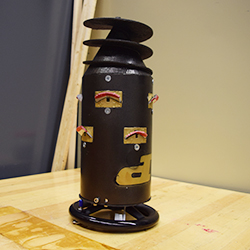Purdue Micro-g NExT team heads to Houston
 Six AAE students have earned the opportunity to test their design skills at the NASA Micro-g Neutral Buoyancy Experiment Design Teams program – Micro-g NExT – activity in Houston May 24-26, 2017. The students are undergraduates from Prof. Steven Collicott’s AAE418 "Zero-gravity Flight Experiment" class.
Six AAE students have earned the opportunity to test their design skills at the NASA Micro-g Neutral Buoyancy Experiment Design Teams program – Micro-g NExT – activity in Houston May 24-26, 2017. The students are undergraduates from Prof. Steven Collicott’s AAE418 "Zero-gravity Flight Experiment" class.
Student teams are challenged to propose, design, build, and test a tool or device that addresses an authentic, current and future space exploration challenge in NASA’s Micro-g NExT program. The Purdue team spent the past two semesters developing a tool to anchor an astronaut to the surface of an asteroid.
 “Being smaller than planets, asteroids have much weaker gravitational force attracting the astronauts to the surface of the asteroid,” says Prof. Collicott. “A way to tether an astronaut or an instrument to the surface is needed.”
“Being smaller than planets, asteroids have much weaker gravitational force attracting the astronauts to the surface of the asteroid,” says Prof. Collicott. “A way to tether an astronaut or an instrument to the surface is needed.”
While at Johnson Space Center the team will test its original design in NASA's Neutral Buoyancy Lab (NBL), a massive swimming pool in which astronauts train for spacewalks and test spaceflight hardware. Professional NBL divers will test the tool while the student team directs them from the Test Conductor Room of the NBL facility. Purdue alumnus and former NASA astronaut David Wolf serves as an expert advisor for the Purdue team. Students will also participate in a series of workshops, design review and testing sessions.
Purdue students on the team are Cody Meyers (team leader), Jason Ang, Kate Bugelholl, Sarah Bugelholl, Nikhil Gupta, and Chris Youngbrand. All are AAE students.
Teams from 29 higher education institutions wrote winning proposal in the fall of 2016 and are participating in the Micro-g NExT program.
top photo: Jason Ang, Chris Youngbrand, Kate Bugelholl (holding anchor tool), Sarah Bugelholl, and Nikhil Gupta. Team Leader Cody Meyers is not pictured.
bottom photo: tool built by the Purdue Micro-g NExT team to anchor an astronaut to the surface of an asteroid
